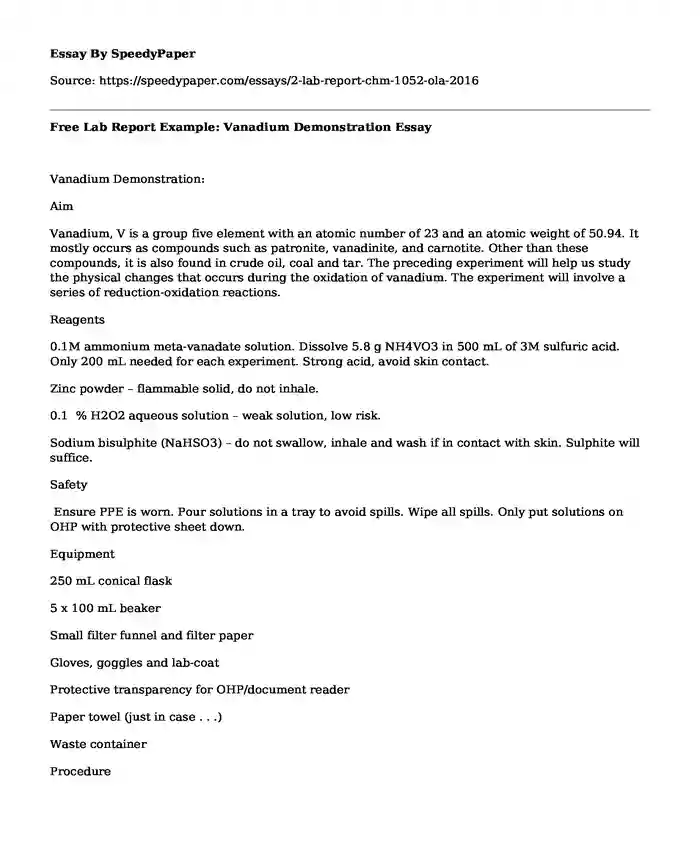
| Type of paper: | Essay |
| Categories: | Problem solving Chemistry |
| Pages: | 3 |
| Wordcount: | 824 words |
Vanadium Demonstration:
Aim
Vanadium, V is a group five element with an atomic number of 23 and an atomic weight of 50.94. It mostly occurs as compounds such as patronite, vanadinite, and carnotite. Other than these compounds, it is also found in crude oil, coal and tar. The preceding experiment will help us study the physical changes that occurs during the oxidation of vanadium. The experiment will involve a series of reduction-oxidation reactions.
Reagents
0.1M ammonium meta-vanadate solution. Dissolve 5.8 g NH4VO3 in 500 mL of 3M sulfuric acid. Only 200 mL needed for each experiment. Strong acid, avoid skin contact.
Zinc powder – flammable solid, do not inhale.
0.1 % H2O2 aqueous solution – weak solution, low risk.
Sodium bisulphite (NaHSO3) – do not swallow, inhale and wash if in contact with skin. Sulphite will suffice.
Safety
Ensure PPE is worn. Pour solutions in a tray to avoid spills. Wipe all spills. Only put solutions on OHP with protective sheet down.
Equipment
250 mL conical flask
5 x 100 mL beaker
Small filter funnel and filter paper
Gloves, goggles and lab-coat
Protective transparency for OHP/document reader
Paper towel (just in case . . .)
Waste container
Procedure
Pour 50 mL of the vanadate solution over excess Zn in a 250 mL conical flask. Swirl. Colour will go green-blue-green-violet (first green is composite of yellow and blue, not indicative of a single oxidation state). If this solution is left to stand once zinc is filtered it will slowly oxidise to V(III), although maybe not totally on time-scale of lecture (eventually goes to V(IV)). H2 is from reaction of Zn with acid – nothing to do with the reduction. Take 50 mL of vanadate solution in 100 mL flask and add a small spatula of bisulphite a bit at a time, swirl. This will reduce only as far as the blue V(IV) state. This state is passed through quickly in the Zn reaction. Take the violet solution from 1, filter half of the solution into 100 mL flask. Keep some so that all colours can be seen at the end of the experiment. Add peroxide dropwise to oxidise back to V(III) which should be green.
Reactions
Step 1: 2VO3- (aq) [yellow] + Zn (s) + 8H+ (aq) ---> 2VO2+ (aq) [blue] + Zn2+ (aq) + 4H2O
2VO2+ (aq) [blue] + Zn + 4H+ (aq) ---> 2V3+ (aq) [green] + Zn2+ (aq) + 2H2O
2V3+ (aq) [green] + Zn ----> 2V2+ (aq) [purple] + Zn2+ (aq)
Note that the complex ions will have H2O coordinated, E.g. [VO(H2O)5]2+ and [V(H2O)6]3+.
Step 2: 2VO3- (aq) [purple] + SO32- (aq) + 6H+ (aq) ---> 2VO2+ (aq) [blue] + SO42- (aq) + 3H2O
Step 3: 2V2+ (aq) [purple] + H2O2 (aq) + 2H+ (aq) ---> 2V3+ (aq) [green] + 2H2O
Discussion
Vanadate solution can be obtained from reacting ammonium meta-vanadate with sulphuric acid. Vanadate solution is yellow in color. When zinc is added to the solution in small amount in acidic an acidic condition, then swirled, the colour change gradually from yellow to blue. The vanadate ion is reduced to vanadyl ion by zinc. Zinc is in turn oxidized to zinc ions.
2VO3- (aq) [yellow] + Zn (s) + 8H+ (aq) ---> 2VO2+ (aq) [blue] + Zn2+ (aq) + 4H2O
On addition of excess zinc to the solution, in acidic conditions, the vanadyl ion is reduced further to vanadium (III). The excess zinc will also be oxidized to zinc ions. The excess acid is converted to water.
2VO2+ (aq) [blue] + Zn + 4H+ (aq) ---> 2V3+ (aq) [green] + Zn2+ (aq) + 2H2O
When zinc is further added to the solution, vanadium (III) will be reduced to vanadium (II), which is purple in colour.
2V3+ (aq) [green] + Zn ----> 2V2+ (aq) [purple] + Zn2+ (aq)
Vanadium is therefore less reactive as compared to zinc metal.
When vanadate ion is reacted with a compound with sulphate ions in an acidic medium, vanadium is reduced to vanadyl ion that is blue in colour and sulphite ion oxidized to sulphate ion. Excess hydrogen ions are also oxidized to water. This means that vanadium is less reactive compared to sulphite ion.
2VO3- (aq) [purple] + SO32- (aq) + 6H+ (aq) ---> 2VO2+ (aq) [blue] + SO42- (aq) + 3H2O
When vanadium (II) is reacted with acidic hydrogen peroxide, vanadium (III) is formed. Vanadium is oxidized from vanadium (II) to Vanadium (III). Hydrogen peroxide is then reduced to water.
2V2+ (aq) [purple] + H2O2 (aq) + 2H+ (aq) ---> 2V3+ (aq) [green] + 2H2O
Vanadium is more reactive than peroxide ion and as such is able to reduce it to water.
Conclusion
Vanadium is less reactive compared to zinc and sulphate ion. This is why zinc is able to reduce it from its compound. However, vanadium is quite reactive in comparison to hydrogen peroxide. In the case where vanadium is less reactive, it is reduced by the other compound and the compound is oxidized. Where vanadium is more reactive, it is the one that is oxidized.
Cite this page
Free Lab Report Example: Vanadium Demonstration. (2017, Oct 26). Retrieved from https://speedypaper.net/essays/2-lab-report-chm-1052-ola-2016
Request Removal
If you are the original author of this essay and no longer wish to have it published on the SpeedyPaper website, please click below to request its removal:
- Cultural Morality Essay Sample for Free Use
- College Education Essay Example
- Essay Example on Cultural Psychology
- HRM Essay Sample: Hiring Procedures
- Essay Example on Strategic Management and Rational Planning Model
- Essay Sample Dedicated to the Intervention of Diabetes in Adults
- Concepts of Inter-Professional and Collaborative Practice
Popular categories




